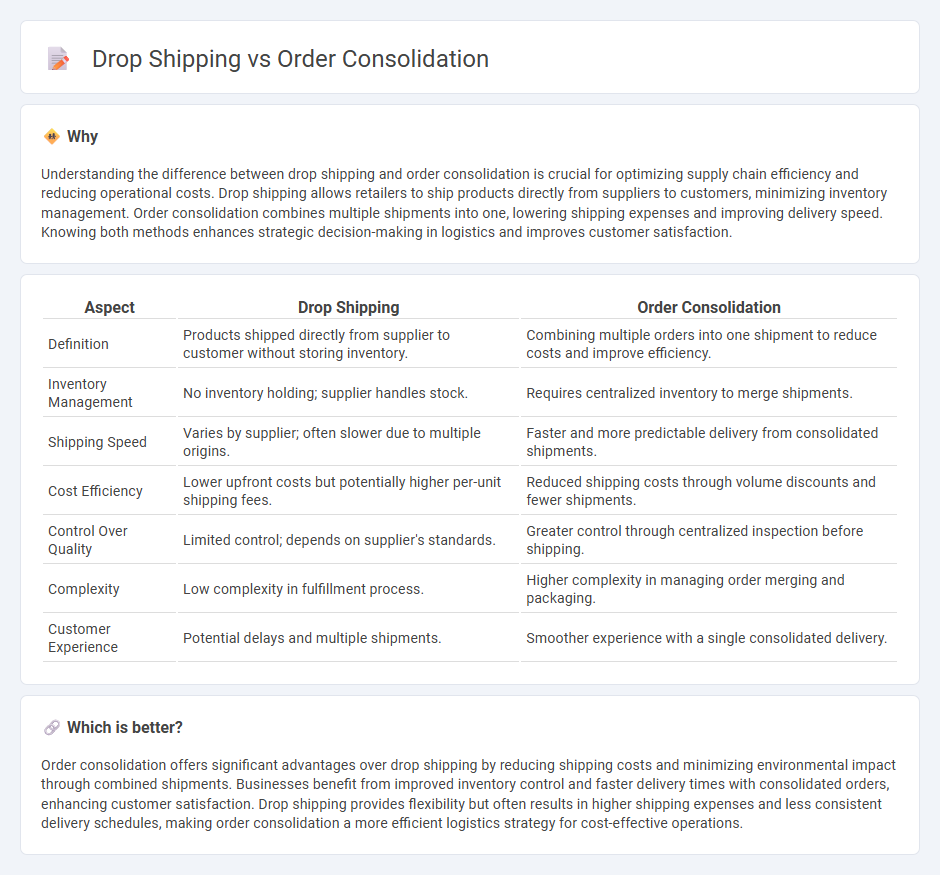
Dropshipping enables retailers to sell products without holding inventory, relying on suppliers to ship directly to customers, which reduces storage costs and speeds up delivery. Order consolidation aggregates multiple orders into a single shipment, optimizing shipping costs and minimizing environmental impact by reducing the number of deliveries. Explore the key differences and benefits of dropshipping versus order consolidation to enhance your logistics strategy.
Why it is important
Understanding the difference between drop shipping and order consolidation is crucial for optimizing supply chain efficiency and reducing operational costs. Drop shipping allows retailers to ship products directly from suppliers to customers, minimizing inventory management. Order consolidation combines multiple shipments into one, lowering shipping expenses and improving delivery speed. Knowing both methods enhances strategic decision-making in logistics and improves customer satisfaction.
Comparison Table
| Aspect | Drop Shipping | Order Consolidation |
|---|---|---|
| Definition | Products shipped directly from supplier to customer without storing inventory. | Combining multiple orders into one shipment to reduce costs and improve efficiency. |
| Inventory Management | No inventory holding; supplier handles stock. | Requires centralized inventory to merge shipments. |
| Shipping Speed | Varies by supplier; often slower due to multiple origins. | Faster and more predictable delivery from consolidated shipments. |
| Cost Efficiency | Lower upfront costs but potentially higher per-unit shipping fees. | Reduced shipping costs through volume discounts and fewer shipments. |
| Control Over Quality | Limited control; depends on supplier's standards. | Greater control through centralized inspection before shipping. |
| Complexity | Low complexity in fulfillment process. | Higher complexity in managing order merging and packaging. |
| Customer Experience | Potential delays and multiple shipments. | Smoother experience with a single consolidated delivery. |
Which is better?
Order consolidation offers significant advantages over drop shipping by reducing shipping costs and minimizing environmental impact through combined shipments. Businesses benefit from improved inventory control and faster delivery times with consolidated orders, enhancing customer satisfaction. Drop shipping provides flexibility but often results in higher shipping expenses and less consistent delivery schedules, making order consolidation a more efficient logistics strategy for cost-effective operations.
Connection
Drop shipping and order consolidation are connected through their roles in optimizing supply chain efficiency by reducing inventory holding costs and streamlining shipment processes. Drop shipping enables retailers to ship products directly from suppliers to customers without warehousing, while order consolidation combines multiple orders into a single shipment to minimize transportation expenses and delivery times. Integrating drop shipping with order consolidation enhances logistical performance by balancing direct fulfillment with bulk shipping benefits, improving customer satisfaction and reducing operational costs.
Key Terms
Order Consolidation:
Order consolidation streamlines supply chain processes by combining multiple orders into a single shipment, reducing shipping costs and minimizing environmental impact through fewer delivery trips. This method enhances inventory management efficiency and accelerates fulfillment time by coordinating products from various suppliers into one package for customers. Discover how order consolidation can optimize logistics and improve customer satisfaction in your business operations.
Freight Optimization
Order consolidation reduces freight costs by combining multiple shipments into a single delivery, enhancing transportation efficiency and minimizing handling expenses. Drop shipping transfers logistical responsibilities to suppliers, potentially increasing freight complexity due to multiple origins and shipment schedules. Explore deeper insights into freight optimization strategies to maximize supply chain efficiency.
Inventory Pooling
Order consolidation leverages inventory pooling by combining multiple customer orders into a single shipment, reducing shipping costs and improving delivery efficiency. Drop shipping eliminates the need for holding inventory by directly shipping products from suppliers to customers, bypassing centralized inventory pools. Explore the benefits and challenges of inventory pooling in both strategies to optimize your supply chain management.
Source and External Links
Order Consolidation: Definition, Steps, Best Practices - This article provides a comprehensive overview of order consolidation, including its definition, steps, and best practices to enhance supply chain efficiency.
Order Consolidation Explained - This resource explains order consolidation as a strategy to merge multiple purchase orders into a single shipment, reducing costs and enhancing sustainability.
Order Consolidation, Staging and Buffering - This page discusses the process of consolidating orders into single shipments, addressing challenges in omnichannel retail and utilizing various logistical solutions.
 dowidth.com
dowidth.com